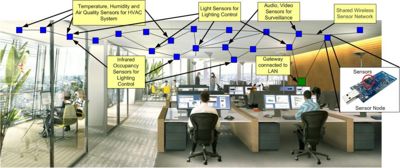Difference between revisions of "Building Automation"
| Line 9: | Line 9: | ||
* real time monitoring and analysis | * real time monitoring and analysis | ||
| − | In this project we try to explore the use of WSNs for building automation. The use of sensor networks for building automation enables '''high-density sensing''' and control at '''lower operational costs''' and could therefore enable more efficient building management. The figure on the right shows an example of a WSN deployment for building automation. | + | In this project we try to explore the use of WSNs for building automation. The use of wireless sensor networks for building automation enables '''high-density sensing''' and control at '''lower operational costs''' and could therefore enable more efficient building management. The figure on the right shows an example of a WSN deployment for building automation. |
Revision as of 07:20, 29 April 2008
Building automation was identified, a few years ago, as a major means of reducing energy usage in buildings. Some already installed building automation systems (BAS) have achieved between 20% to 80% reductions in energy cost, increased occupant security/safety, increased occupant comfort and a reduction in building operations cost. Although several building automation systems have been installed so far, they have not yet achieved a significant market penetration nor have they successfully achieved their full potential. Several issues still remain unresolved, like:
- increased interoperability between individual sub-systems like HVAC, lighting control etc.
- use of wireless sensors that facilitate reduced installation/wiring cost
- increased information sharing between the various sub-systems
- integration with installed IT enterprise networks
- better application modeling and deployment toolkit
- real time monitoring and analysis
In this project we try to explore the use of WSNs for building automation. The use of wireless sensor networks for building automation enables high-density sensing and control at lower operational costs and could therefore enable more efficient building management. The figure on the right shows an example of a WSN deployment for building automation.
Contents
Sensors
Resources
- NIST Project, Development of testbed for wireless sensor network use in buildings
- DOE report, Advanced Sensors and Controls for Building Applications: Market Assessment and Potential R&D Pathways
- Sensor Networks for Building Automation: Energy Efficiency
- Interesting List of Data Sources
Companies
- Millennial Net
- Ember
- Gridlogic
- Siemens
- Honeywell
- Echelon
People
This work is being conducted by Sangeeta Bhattacharya, a current PhD student, under the guidance of Dr. Chenyang Lu and Dr. Gruia-Catalin Roman.
